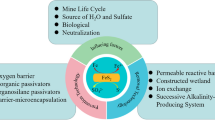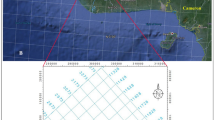Abstract
Exploration of low-sulfidation epithermal Au deposits is expected to increase because these deposits are economically competitive and globally occurring as well as produce low environmental load via underground mining. Drilling is the main exploration tool for identifying mineralized zones in three dimensions; however, selecting drill targets is a major technical challenge in exploration work. This challenge can be addressed by effectively employing our conceptual model of a “cold-water trap,” an ore-deposition mechanism induced by cold groundwater in shallow aquifer. In two previous case studies on low-sulfidation epithermal deposits, this mechanism was verified via geological modeling and numerical simulations, and potential mineralized zones were three-dimensionally confirmed in undrilled areas. Here, we methodize the utilization of numerical simulations for epithermal Au exploration and prepare the operational guidelines for a new exploration method. In this method, the trapping scenario can be modified to explore deposits generated by incomplete cold-water trapping. Because this method functions effectively from the time at which the necessary data for geological modeling are obtained, it is adapted to operate over the time of drill exploration. Furthermore, the proposed method can be adapted to brownfield explorations, such as around the existing deposits. Sensitivity analysis revealed permeability to be the most important parameter for the numerical simulation. Analyzing drill cores with respect to fracture properties such as width and density as well as the extent of the hydrothermal alteration halo is crucial for the accurate estimation of permeability.











Similar content being viewed by others
References
ADA International Consulting. (2000). TETRAD 2000 user manual. Calgary, Canada.
Ezekiel, J., Adams, B. M., Saar, M. O., & Ebigbo, A. (2022). Numerical analysis and optimization of the performance of CO2-plume geothermal (CPG) production wells and implications for electric power generation. Geothermics, 98, 102270.
Fan, X., Hu, Z., Xu, S., Chen, C., & Yi, N. (2021). Numerical simulation study on ore-forming factors of the Gejiu ore deposit, China. Ore Geology Reviews, 135, 1–15.
Garg, S. K., & Pritchett, J. W. (2001). Development of new geothermal wellbore holdup correlations using flowing well data. Report No. SAIC-01/1061. Science Applications International Corporation, San Diego, California.
Grancea, L., Bailly, L., Leroy, J., Banks, D., Marcoux, E., Milési, J. P., Cuney, M., André, A. S., Istvan, D., & Fabre, C. (2002). Fluid evolution in the Baia Mare epithermal gold/polymetallic district, Inner Carpathians, Romania. Mineralium Deposita, 37, 630–647.
Hayashi, K., Maruyama, T., & Sato, H. (2000). Submillimeter scale variation of oxygen isotope of vein quartz at the Hishikari deposit, Japan. Resource Geology, 50(3), 141–150.
Hedenquist, J. W., Arribas, R. A., & Gonzales-Urien, E. (2000). Exploration for epithermal gold deposits. Reviews in Economic Geology, 13, 245–277.
Henley, R. W., & Ellis, A. J. (l983). Geothermal systems, ancient and modern. Earth Science Review, 19(1), 1–50.
Hu, X., Chen, Y., Liu. G., Yang, H., Luo, J., Ren, K., & Yang, Y. (2022). Numerical modeling of formation of the Maoping Pb–Zn deposit within the Sichuan–Yunnan–Guizhou Metallogenic Province, Southwestern China: Implications for the spatial distribution of concealed Pb mineralization and its controlling factors. Ore Geology Reviews, 140, l–11.
Hua, X., Lia, X., Yuana, F., Orda, A., Jowitt, S.M., Lia, Y., Daia., W., & Zhoua, T. (2020). Numerical modeling of ore-forming processes within the Chating Cu–Au porphyry-type deposit, China: Implications for the longevity of hydrothermal systems and potential uses in mineral exploration. Ore Geology Reviews, 116, l–16.
Huang, L., Wang, G., Carranza, E. J. M., Du, J., Li, J., Zhou, Z., Zhang, Z., Wang, H., Liu, X., Peng, Y., Gao, F., & Zhao, X. (2020). Multi-scale numerical simulation and 3D modeling for deep mineral exploration in the Jiaojia gold district, China. Natural Resources Research, 29(1), 415–438.
Ibaraki, K., & Suzuki, R. (1990). Wall-rock alteration in the Hishikari gold mine, Kagoshima Prefecture, Japan. Mining Geology, 40, 97–106. in Japanese with English abs.
Ingebritsen, S. E., Geiger, S., Hurwitz, S., & Driesner, T. (2010). Numerical simulation of magmatic hydrothermal systems. Reviews of Geophysics, 48, RG1002.
Jung, Y., Pau, G. S. H., Finsterle, S., & Doughty, C. A. (2021). TOUGH3 user’s guide, Version 1.0.
Itoh, K. (1979). Fracture in the Hosokura deposit–Forming mechanism of the bonanza–. Technical report of Mining Division, Mitsubishi Materials Corporation, 143, 3–24 (in Japanese).
Moncada, D., Mutchler, S., Nieto, A., Reynolds, T. J., Rimstidt, J. D., & Bodnar, R. J. (2012). Mineral textures and fluid inclusion petrography of the epithermal Ag–Au deposits at Guanajuato, Mexico: Application to exploration. Journal of Geochemical Exploration, 114, 20–35.
Moon, C., Whateley, M. K. G., & Evans, A. M. (Eds.). (2009). Introduction to mineral exploration (2nd ed., p. 496). Blackwell Publishing.
Narita, E. (1961). Wall rock alteration in the Kanoko vein swarm, Hosokura mine, Miyagi prefecture, north-east Japan. Journal of the Faculty of Science, Hokkaido University, Series 4, Geology and Mineralogy, 11(1), 59–75.
Okabe, K., & Bamba, T. (1976). Propylite and alteration halo around the Pb–Zn vein of Toyoha mine, west Hokkaido, Japan. Mining Geology, 26(4), 239–251. in Japanese with English abs.
Pruess, K., Oldenburg, C., & Moridis, G. (1999). TOUGH2 user's guide, Version 2.0. Earth Sciences Division, p. 198.
Sato, J., Maeda, H., Kinryu, Y., & Ono, S. (1980). Mineral paragenesis and fluid inclusion data of the Oe polymetallic vein-type deposits, Hokkaido, Japan. Mining Geology, 30(5), 277–288.
Shimizu, T. (2014). Reinterpretation of quartz textures in terms of hydrothermal fluid evolution at the Koryu Au–Ag deposit, Japan. Economic Geology, 109(7), 2051–2065.
Takahashi, H. (1988). Wall-rock alteration and ore-formation model of Hosokura Pb–Zn ore deposits, Japan. Mining Geology, 38(4), 335–346. in Japanese with English abs.
Takahashi, H., Tomita, S. A., Koike, K., & Yoshiyama, H. (2021). A cold-water trap as an essential process for the generation of low-sulfidation epithermal deposits: Geological and numerical studies of the Hosokura deposit, Northern Japan. Ore Geology Reviews, 128, 1–22.
Takahashi, H., Tomita, S. A., Koike, K., & Yoshiyama, H. (2022). Geological modeling and numerical simulation of a cold-water trap in the low-sulfidation epithermal Sirawai Au–Ag deposit, Mindanao, Philippines. Natural Resources Research, 31(1), 67–98.
Takatori, I., & Nouno, M. (1985). Geochemical characteristics of Chitose Fukujinzawa ore deposit. An approach to exploration for gold–silver deposits. Gold and silver ore in Japan. Mining and Metallurgical Institute of Japan, 3, 19–60. in Japanese.
Takenouchi, S. (1983). Fluid inclusion study of the Nansatsu-type gold deposits, Southern Kyushu. Mining Geology, 33(4), 237–245. in Japanese with English abs.
Tsuchiya, N., Itoh, J., Seki, Y., & Iwaya, T. (1997). Geology of the Iwagasaki district, with Geological sheet map at 1:50,000. Geol. Surv. Japan, Tsukuba, p. 96 (in Japanese with English abs.).
Tsukada, Y., & Uno, S. (1980). On the hydrothermal alteration halo associated with the Oe Mn–Pb–Zn mineralization, west Hokkaido. Mining Geology, 30(2), 63–72. in Japanese with English abs.
Ueda, A., Ajima, S., & Yamamoto, M. (2001). Isotopic study of carbonate minerals from the Sumikawa geothermal area and its application to water movement. Journal of Geothermal Research Society Japan, 23, 181–196. in Japanese with English abstract.
White, N. C., & Hedenquist, J. W. (1995). Epithermal gold deposits: Styles, characteristics, and exploration. SEG Newsletter, 23(1), 9–13.
Yoshiyama, H. (2005). Evolution of volcanic and hydrothermal activities based on the thermo-luminescence ages at geothermal fields. Doctoral thesis. Kyushu University, Fukuoka, Japan, p. 92
Yumul, G. P., Jr., Dimalanta, C. B., Tamayo, R. A., Jr., Maury, R. C., Bellon, H., Polvé, M., Maglambayan, V. B., Querubin, C. L., & Cotten, J. (2004). Geology of the Zamboanga Peninsula, Mindanao, Philippines: An enigmatic South China continental fragment? Geological Society, London, Special Publications, 226, 289–312.
Acknowledgments
The first author wishes to thank the collaborators who have collected samples and conducted geological surveys in the Hosokura and Sirawai deposits. We are grateful to Dr. Steve Ingebritsen, Dr. Jonathan Naden, and one anonymous reviewer for essential and constructive comments and suggestions that improved the clarity of this manuscript.
Author information
Authors and Affiliations
Corresponding author
Ethics declarations
Conflict of Interest
The authors declare that they have no known competing financial interests or personal relationships that could have appeared to influence the work reported in this paper.
Rights and permissions
Springer Nature or its licensor (e.g. a society or other partner) holds exclusive rights to this article under a publishing agreement with the author(s) or other rightsholder(s); author self-archiving of the accepted manuscript version of this article is solely governed by the terms of such publishing agreement and applicable law.
About this article
Cite this article
Takahashi, H., Tomita, S.A., Koike, K. et al. Utilization and Effectiveness of Numerical Simulation Based on a Cold-Water Trapping Mechanism for Epithermal Gold Exploration. Nat Resour Res 32, 129–145 (2023). https://doi.org/10.1007/s11053-022-10139-3
Received:
Accepted:
Published:
Issue Date:
DOI: https://doi.org/10.1007/s11053-022-10139-3




